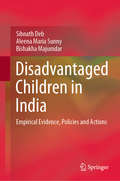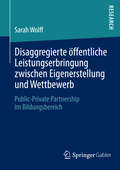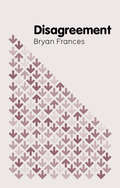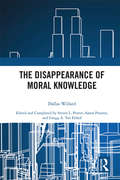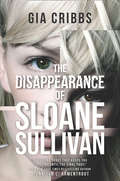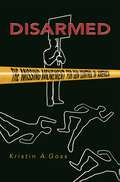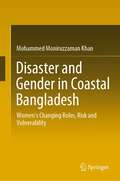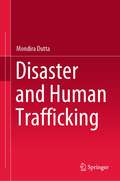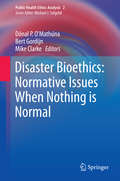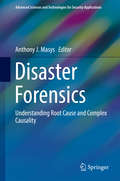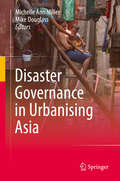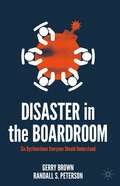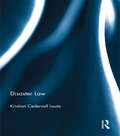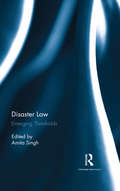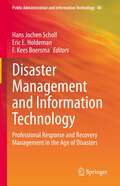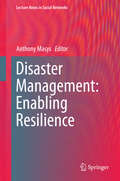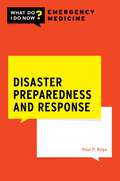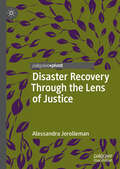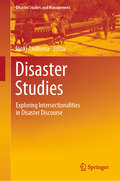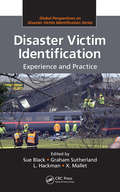- Table View
- List View
Disadvantaged Children in India: Empirical Evidence, Policies and Actions
by Sibnath Deb Aleena Maria Sunny Bishakha MajumdarThis book addresses issues concerning five major categories of disadvantaged children, namely street children, children involved in trafficking, child labor, slum children, and children in institutional care, which apply to a large number of children around the world, including India. Compiling primary and secondary research-based evidences in addition to the first-hand experiences of the authors, it describes the link between social dynamics and the plight of disadvantaged children from both social and cultural perspectives. Each chapter includes examples and case studies to offer readers essential insights into the real-life situations of these children. At the end of each chapter, a number of evidence-based measures and models are proposed for agencies working to support disadvantaged children. Given its comprehensive coverage, the book is of interest to scholars, and government and non-government agencies involved in the welfare of disadvantaged children, funding agencies, and social science, medical and public health professionals.
Disaggregierte öffentliche Leistungserbringung zwischen Eigenerstellung und Wettbewerb: Public-Private Partnership im Bildungsbereich
by Sarah WolffPPP haben sich in Deutschland und international als wünschenswerte Beschaffungsalternative der Öffentlichen Hand etabliert. Dabei spielt vor allem die Kosteneffizienz gegenüber der Eigenerstellung durch die Öffentliche Hand eine Rolle. Aber bewirtschaften private Unternehmen staatlich geschützte Monopole auf Zeit wirklich effizient? Und wenn ja, wie viel effizienter könnte dann eine marktliche Bereitstellung sein? Erwirtschaften PPP wirklich Mehrwert für den Bürger oder sind sie verstecktes Mittel zusätzlicher Besteuerung? Und sind (beinahe) insolvente öffentliche Haushalte wirklich ein starker Verhandlungspartner gegenüber weltweit agierenden Baukonzernen? Sarah Wolff gibt Antworten auf diese und andere Fragen.
Disagreement (Key Concepts in Philosophy)
by Bryan FrancesRegardless of who you are or how you live your life, you disagree with millions of people on an enormous number of topics from politics, religion and morality to sport, culture and art. Unless you are delusional, you are aware that a great many of the people who disagree with you are just as smart and thoughtful as you are - in fact, you know that often they are smarter and more informed. But believing someone to be cleverer or more knowledgeable about a particular topic usually won’t change your mind. Should it? This book is devoted to exploring this quandary - what should we do when we encounter disagreement, particularly when we believe someone is more of an authority on a subject than we are? The question is of enormous importance, both in the public arena and in our personal lives. Disagreement over marriages, beliefs, friendships and more causes immense personal strife. People with political power disagree about how to spend enormous amounts of money, about what laws to pass, or about wars to fight. If only we were better able to resolve our disagreements, we would probably save millions of lives and prevent millions of others from living in poverty. The first full-length text-book on this philosophical topic, Disagreement provides students with the tools they need to understand the burgeoning academic literature and its (often conflicting) perspectives. Including case studies, sample questions and chapter summaries, this engaging and accessible book is the perfect starting point for students and anyone interested in thinking about the possibilities and problems of this fundamental philosophical debate.
The Disappearance of Moral Knowledge
by Dallas WillardBased on an unfinished manuscript by the late philosopher Dallas Willard, this book makes the case that the 20th century saw a massive shift in Western beliefs and attitudes concerning the possibility of moral knowledge, such that knowledge of the moral life and of its conduct is no longer routinely available from the social institutions long thought to be responsible for it. In this sense, moral knowledge—as a publicly available resource for living—has disappeared. Via a detailed survey of main developments in ethical theory from the late 19th through the late 20th centuries, Willard explains philosophy’s role in this shift. In pointing out the shortcomings of these developments, he shows that the shift was not the result of rational argument or discovery, but largely of arational social forces—in other words, there was no good reason for moral knowledge to have disappeared. The Disappearance of Moral Knowledge is a unique contribution to the literature on the history of ethics and social morality. Its review of historical work on moral knowledge covers a wide range of thinkers including T.H Green, G.E Moore, Charles L. Stevenson, John Rawls, and Alasdair MacIntyre. But, most importantly, it concludes with a novel proposal for how we might reclaim moral knowledge that is inspired by the phenomenological approach of Knud Logstrup and Emmanuel Levinas. Edited and eventually completed by three of Willard’s former graduate students, this book marks the culmination of Willard’s project to find a secure basis in knowledge for the moral life.
The Disappearance of Moral Knowledge
by Dallas WillardBased on an unfinished manuscript by the late philosopher Dallas Willard, this book makes the case that the 20th century saw a massive shift in Western beliefs and attitudes concerning the possibility of moral knowledge, such that knowledge of the moral life and of its conduct is no longer routinely available from the social institutions long thought to be responsible for it. In this sense, moral knowledge—as a publicly available resource for living—has disappeared. Via a detailed survey of main developments in ethical theory from the late 19th through the late 20th centuries, Willard explains philosophy’s role in this shift. In pointing out the shortcomings of these developments, he shows that the shift was not the result of rational argument or discovery, but largely of arational social forces—in other words, there was no good reason for moral knowledge to have disappeared. The Disappearance of Moral Knowledge is a unique contribution to the literature on the history of ethics and social morality. Its review of historical work on moral knowledge covers a wide range of thinkers including T.H Green, G.E Moore, Charles L. Stevenson, John Rawls, and Alasdair MacIntyre. But, most importantly, it concludes with a novel proposal for how we might reclaim moral knowledge that is inspired by the phenomenological approach of Knud Logstrup and Emmanuel Levinas. Edited and eventually completed by three of Willard’s former graduate students, this book marks the culmination of Willard’s project to find a secure basis in knowledge for the moral life.
The Disappearance Of Sloane Sullivan (Hq Young Adult Ebook Ser.)
by Gia CribbsThere are worse things than disappearing.
Disarmed: The Missing Movement for Gun Control in America
by Kristin A. GossMore than any other advanced industrial democracy, the United States is besieged by firearms violence. Each year, some 30,000 people die by gunfire. Over the course of its history, the nation has witnessed the murders of beloved public figures; massacres in workplaces and schools; and epidemics of gun violence that terrorize neighborhoods and claim tens of thousands of lives. Commanding majorities of Americans voice support for stricter controls on firearms. Yet they have never mounted a true national movement for gun control. Why? Disarmed unravels this paradox. Based on historical archives, interviews, and original survey evidence, Kristin Goss suggests that the gun control campaign has been stymied by a combination of factors, including the inability to secure patronage resources, the difficulties in articulating a message that would resonate with supporters, and strategic decisions made in the name of effective policy. The power of the so-called gun lobby has played an important role in hobbling the gun-control campaign, but that is not the entire story. Instead of pursuing a strategy of incremental change on the local and state levels, gun control advocates have sought national policies. Some 40% of state gun control laws predate the 1970s, and the gun lobby has systematically weakened even these longstanding restrictions. A compelling and engagingly written look at one of America's most divisive political issues, Disarmed illuminates the organizational, historical, and policy-related factors that constrain mass mobilization, and brings into sharp relief the agonizing dilemmas faced by advocates of gun control and other issues in the United States.
Disarmed: The Missing Movement for Gun Control in America (PDF)
by Kristin A. GossMore than any other advanced industrial democracy, the United States is besieged by firearms violence. Each year, some 30,000 people die by gunfire. Over the course of its history, the nation has witnessed the murders of beloved public figures; massacres in workplaces and schools; and epidemics of gun violence that terrorize neighborhoods and claim tens of thousands of lives. Commanding majorities of Americans voice support for stricter controls on firearms. Yet they have never mounted a true national movement for gun control. Why? Disarmed unravels this paradox. Based on historical archives, interviews, and original survey evidence, Kristin Goss suggests that the gun control campaign has been stymied by a combination of factors, including the inability to secure patronage resources, the difficulties in articulating a message that would resonate with supporters, and strategic decisions made in the name of effective policy. The power of the so-called gun lobby has played an important role in hobbling the gun-control campaign, but that is not the entire story. Instead of pursuing a strategy of incremental change on the local and state levels, gun control advocates have sought national policies. Some 40% of state gun control laws predate the 1970s, and the gun lobby has systematically weakened even these longstanding restrictions. A compelling and engagingly written look at one of America's most divisive political issues, Disarmed illuminates the organizational, historical, and policy-related factors that constrain mass mobilization, and brings into sharp relief the agonizing dilemmas faced by advocates of gun control and other issues in the United States.
Disaster and Gender in Coastal Bangladesh: Women’s Changing Roles, Risk and Vulnerability
by Mohammed Moniruzzaman KhanThis volume explores the discourse of disaster and women in the existing social settings and state disaster-related affairs in coastal Bangladesh. It covers various issues ranging from disproportionate vulnerability, coping and adaptation mechanisms for women, limitations for promoting participation and involvement of women in the decision-making process both in family and community and changes in the role and responsibilities of women for reducing disaster risk and vulnerability. It contributes to the deconstruction of gender-based identity by addressing women's changing practices and roles in the coastal area in terms of the involvement of women with the development process, earning/income generation activities, decision-making process, access and entitlements to resources. This book presents the most current and inclusive circumstances of disaster and women of the coastal area in Bangladesh. The insights obtained through the eyes of a sociologist from a holistic perspective make this book different and unique. The book is of interest to researchers, academics, policymakers and professionals engaged in the social understanding of disaster studies, as well as to researchers and practitioners in interdisciplinary domains, including sociology, gender studies, social work, environmental studies, and development studies.
Disaster and Human Trafficking
by Mondira DuttaThe book highlights the root cause of human trafficking and analyses how factors of vulnerability affect the marginalized, especially during and after a disaster. Human trafficking like other studies on disaster research, needs to be tackled from various perspectives such as empowering the vulnerable people, creating awareness, strengthening the disaster risk reduction measures and creating a common platform to fight the vicious circle by breaking its continuity and making strategies victim centric and people friendly.The book adapts a multidisciplinary approach embedding concepts from political, social, economic and anthropological perceptions. The discourse in the book revolves around the emotional and psycho-social stress factors including weak implementation of laws and policies at various levels. The content weaves around three themes -- magnitude and interlinks between disaster and human trafficking; policies and protocols on disaster risk reduction and human trafficking and community participation and institutional support. Through these themes, the volume works on identification of the vulnerable areas which are not in compliance with the Sendai Framework of Action, 2015 in the backdrop of the Disaster Management Act of India, 2005. The volume will be of immense interest to a wide range of practitioners, researchers, academicians, policy makers, political leaders, gender experts, international organizations, disaster management authorities, civil society organisations, and scholars working in the area of human rights in general and trafficking in particular. Note: This research was funded by Indian Council of Social Science Research (ICSSR).Human Trafficking is complex, layered and lies at the intersections of multiple vulnerabilities, gender being among the most significant ones. This gets exacerbated during both natural and human made disasters. Any attempt to either understand or address it will be fraught with challenges if women and girls' unique vulnerabilities, as well as their needs, voice, choice, agency and safety is not centre-staged in any effort. Mondira's book does exactly that...it succinctly and in simple words explores the compounding discriminations, including structural inequalities, that cause and result in women and girls differential gendered vulnerabilities to being trafficked during disasters. Once this is understood, the solutions can be specific, gender responsive, and sustainable.- Anju Dubey Pandey, Gender Responsive Governance and Ending Violence against Women Specialist, UN Women, New Delhi, India
Disaster Bioethics: Normative Issues When Nothing Is Normal (Public Health Ethics Analysis #2)
by Dónal P. O’Mathúna Bert Gordijn Mike ClarkeThis book provides an early exploration of the new field of disaster bioethics:examining the ethical issues raised by disasters. Healthcare ethics issues are addressed in the first part of this book. Large-scale casualties lead to decisions about who to treat and who to leave behind, cultural challenges, and communication ethics. The second part focuses on disaster research ethics.With the growing awareness of the need for evidence to guide disaster preparedness and response, more research is being conducted in disasters. Any research involving humans raises ethical questions and requires appropriate regulation and oversight. The authors explore how disaster research can take account of survivors? vulnerability, informed consent, the sudden onset of disasters, and other ethical issues. Both parts examine ethical challenges where seeking to do good, harm can be done. Faced with overwhelming needs and scarce resources, no good solution may be apparent. But choosing the less wrong option can have a high price. In addition, what might seem right at home may not be seen to be right elsewhere. This book provides in-depth and practical reflection on these and other challenging ethical questions arising during disasters.Scholars and practitioners who gathered at the Brocher Foundation in Geneva, Switzerland in 2011 offer their reflections to promote further dialogue so that those devastated by disasters are respected by being treated in the most ethically sound ways possible.
Disaster Forensics: Understanding Root Cause and Complex Causality (Advanced Sciences and Technologies for Security Applications)
by Anthony J. MasysThis book aims to uncover the root causes of natural and man-made disasters by going beyond the typical reports and case studies conducted post-disaster. It opens the black box of disasters by presenting ‘forensic analysis approaches’ to disasters, thereby revealing the complex causality that characterizes them and explaining how and why hazards do, or do not, become disasters. This yields ‘systemic’ strategies for managing disasters.Recently the global threat landscape has seen the emergence of high impact, low probability events. Events like Hurricane Katrina, the Great Japan Earthquake and tsunami, Hurricane Sandy, Super Typhoon Haiyan, global terrorist activities have become the new norm. Extreme events challenge our understanding regarding the interdependencies and complexity of the disaster aetiology and are often referred to as Black Swans. Between 2002 and 2011, there were 4130 disasters recorded that resulted from natural hazards around the world. In these, 1,117,527 people perished and a minimum of US$1,195 billion in losses were reported. In the year 2011 alone, 302 disasters claimed 29,782 lives; affected 206 million people and inflicted damages worth a minimum of estimated US$366 billion.
Disaster Governance in Urbanising Asia
by Michelle Ann Miller Mike DouglassThis edited book approaches the threat and impact of environmental disasters on Asia’s urban populations from a governance perspective. It adopts a multi-sector and multi-disciplinary approach to disaster governance that emphasises the importance of multiple stakeholders in preparing for, responding to and recovering from disasters and their cascading impacts in Asia’s cities. The contributors to this volume take a broad view of the multifaceted causalities and the interconnected threats and vulnerabilities of environmental disasters in urbanising Asia. As such, the book is an invitation to advance scholarship in the search for more effective, comprehensive and inclusive disaster preparedness agendas, recovery programs and development priorities.
Disaster in the Boardroom: Six Dysfunctions Everyone Should Understand
by Gerry Brown Randall S. PetersonWhy when companies come crashing down, do we hear of boards who have failed in their fiduciary duties? Or that they have been ignorant, complacent or downright complicit in these scandals and downfalls? Of course, corporate scandals are nothing new, nor are they limited to any one geography. They are a damning indictment of our systems of corporate governance around the world. And yet, despite this frequency, little or nothing changes. We shrug and move on, accepting they are an unavoidable part of the system that produces incredible wealth for economies and societies. But it should not be that way. Disaster in the Boardroom shows how boards can be better. Looking at why these scandals happen, authors Peterson and Brown present in-depth case studies of major global corporations – including recent contemporary scandals associated with companies such as BP, Facebook and Uber – using the optic of their unique, original and compelling ‘six dysfunctions of the board’ analysis to reveal their particularities but also how they can be overcome. In this book, Brown and Peterson explore common attributes of scandals such as lack of independence from management, missing key voices, cultural amplification, diffusion of responsibility, rule-bound cultures and groupthink. They also identify ways to strengthen boards, improve their culture and competence, and give directors and others the power to take action and ultimately prevent disasters from happening. Disaster in the Boardroom is essential reading for every executive in every boardroom, those aspiring to board positions as well as anyone interested in why boards fail. It has never been more important to pre-identify and eradicate these boardroom dysfunctions – not least so that their impacts upon society can better seen, understood, mitigated, and avoided.
Disaster Law
by Kristian Cedervall LautaDisasters and their management are today central to public and political agendas. Rather than being understood as exclusively acts of God and Nature, natural disasters are increasingly analysed as social vulnerability exposed by natural hazards. A disaster following an earthquake is no longer seen as caused exclusively by tremors, but by poor building standards, ineffective response systems, or miscommunications. This book argues that the shift in how a disaster is spoken of and managed affects fundamental notions of duty, responsibility and justice. The book considers the role of law in disasters and in particular the regulation of disaster response and the allocation of responsibility in the aftermath of disasters. It argues that traditionally law has approached emergencies, including natural disasters, from a dichotomy of normalcy and emergency. In the state of emergency, norms were replaced by exceptions; democracy by dictatorship; and rights by necessity. However, as the disaster becomes socialized the idea of a clear distinction between normalcy and emergency crumbles. Looking at international and domestic legislation from a range of jurisdictions the book shows how natural disasters are increasingly normalized and increasingly objects of legal regulation and interpretation. The book will be of great use and interest to scholars and researchers of legal theory, and natural hazards and disasters.
Disaster Law
by Kristian Cedervall LautaDisasters and their management are today central to public and political agendas. Rather than being understood as exclusively acts of God and Nature, natural disasters are increasingly analysed as social vulnerability exposed by natural hazards. A disaster following an earthquake is no longer seen as caused exclusively by tremors, but by poor building standards, ineffective response systems, or miscommunications. This book argues that the shift in how a disaster is spoken of and managed affects fundamental notions of duty, responsibility and justice. The book considers the role of law in disasters and in particular the regulation of disaster response and the allocation of responsibility in the aftermath of disasters. It argues that traditionally law has approached emergencies, including natural disasters, from a dichotomy of normalcy and emergency. In the state of emergency, norms were replaced by exceptions; democracy by dictatorship; and rights by necessity. However, as the disaster becomes socialized the idea of a clear distinction between normalcy and emergency crumbles. Looking at international and domestic legislation from a range of jurisdictions the book shows how natural disasters are increasingly normalized and increasingly objects of legal regulation and interpretation. The book will be of great use and interest to scholars and researchers of legal theory, and natural hazards and disasters.
Disaster Law: Emerging Thresholds
by Amita SinghThis book looks at how legal frameworks can and do reduce risks arising out of disasters. The volume: analyses existing disaster laws and the challenges on the ground; brings together case studies from some of the most vulnerable regions; and proposes solutions to avert existing and possible future crises. The book offers appropriate legal frameworks for disaster management which could not only offer sustainable institutional reforms towards community resilience and preparedness but also reduce risk within the frameworks of justice, equity and accountability. It examines the intricacies of governance within which governments function and discusses how recent trends in infrastructure development and engineering technology could be balanced within the legal principles of ethics, transparency and integrity. The chapters in the volume suggest that legal frameworks ought to resonate with new challenges of resource management and climate change. Further, these frameworks could help secure citizens’ trust, institutional accountability and effective implementation through an unceasing partnership which keeps the community better prepared and more resilient. This volume will be indispensable to scholars and researchers of disaster management, law, public policy, environment and development studies as well as policymakers and those in administrative, governmental, judicial and development sectors.
Disaster Law: Emerging Thresholds
by Amita SinghThis book looks at how legal frameworks can and do reduce risks arising out of disasters. The volume: analyses existing disaster laws and the challenges on the ground; brings together case studies from some of the most vulnerable regions; and proposes solutions to avert existing and possible future crises. The book offers appropriate legal frameworks for disaster management which could not only offer sustainable institutional reforms towards community resilience and preparedness but also reduce risk within the frameworks of justice, equity and accountability. It examines the intricacies of governance within which governments function and discusses how recent trends in infrastructure development and engineering technology could be balanced within the legal principles of ethics, transparency and integrity. The chapters in the volume suggest that legal frameworks ought to resonate with new challenges of resource management and climate change. Further, these frameworks could help secure citizens’ trust, institutional accountability and effective implementation through an unceasing partnership which keeps the community better prepared and more resilient. This volume will be indispensable to scholars and researchers of disaster management, law, public policy, environment and development studies as well as policymakers and those in administrative, governmental, judicial and development sectors.
Disaster Management and Information Technology: Professional Response and Recovery Management in the Age of Disasters (Public Administration and Information Technology #40)
by Hans Jochen Scholl Eric E. Holdeman F. Kees BoersmaThis edited book entertains a multitude of perspectives on crisis information management systems (CIMS)-based disaster response and recovery management. The use of information technology in disaster management has become the central means for collecting, vetting, and distributing information. It also serves as the backbone for coordination and collaboration between response and recovery units as well as resource management tool. This edited volume aims at covering the whole range of application and uses of CIMS in disaster response and recovery. It showcases coordination and collaboration mechanisms between government agencies, the involvement of non-governmental entities, lessons learned as well as lessons not learned, approaches to disaster resiliency in society, community engagement in disaster/catastrophe responses and recovery, and, particularly, the role of CIMS in response and recovery. Serving as a platform for showcasing recent academic discoveries as well as a knowledge source for practitioners, this volume will be of interest to researchers and practitioners interested in disaster response, public administration, emergency management, and information systems.
Disaster Management: Enabling Resilience (Lecture Notes in Social Networks)
by Anthony MasysThe present work will discuss relevant theoretical frameworks and applications pertaining to enabling resilience within the risk, crisis and disaster management domain. The contributions to this book focus on resilience thinking along 4 broad themes: Urban Domain; Cyber Domain; Organizational/Social domain; and Socio-ecological domain. This book would serve as a valuable reference for courses on risk, crisis and disaster management, international development, social innovation and resilience. This will be of particular interest to those working in the risk, crisis and disaster management domain as it will provide valuable insights into enabling resilience. This book will be well positioned to inform disaster management professionals, policy makers and academics on strategies and perspectives regarding disaster resilience.
Disaster Preparedness and Response (WHAT DO I DO NOW EMERGENCY MEDICINE)
by Paul P. RegaDisaster medicine has occupied an increasingly important niche within the specialty of emergency medicine over the latter half of the 20th century. Regardless of whether an event was natural, anthropogenic, or a combination of both, emergency medicine was and is the ideal discipline to develop the human resources, the strategies, the tactics, and the evidence- based research to elevate the field of disaster medicine. It began, organizationally speaking, with Hurricane Hugo in 1989 and it is continuing through the 2019 COVID- 19 pandemic and beyond. Now that we are well into the 21st century, we must steady our footing as a specialty on the 20th century's foundation so that we can wrestle with the more intricate challenges of the future. In the past two decades our global populations have experienced sectarian violence, wars, genocide, migration, terrorism, emerging infectious diseases, and pandemics. These natural and anthropogenic events will only worsen exponentially as we become intrinsically trapped by the effects of climate change. The United Nation's Intergovernmental Panel on Climate Change has recently concluded that regardless of how we try to reverse the effects of global warming, what we are experiencing now in terms of hurricanes, floods, and droughts will continue to worsen over the next 30 years. Should we, as a species, continue to equivocate and as global temperatures climb, these events will become more frequent and more catastrophic. "Catastrophic" may even be too mild a term. It is possible that over the next few years, the academic arm of emergency medicine may need to consider developing a curriculum devoted to "Cataclysmic Medicine." To confront these possibilities, there first needs to be a knowledge of disaster medicine and disaster management at its most basic level. It begins with crisis leadership, command and control, communications, and coordination. When all these pieces of the jigsaw puzzle are fitted together properly and enclosed by a proper ethical frame, then the best and most ethical and moral disaster medical can will be provided to the patient and to the community. The intent of this book is to introduce these concepts using diverse viewpoints and scenarios. Readers are challenged to cogitate, create, and layer their own set of building blocks upon the preexisting foundation, thereby reinforcing and sustaining their own capacity to prepare for and respond to any adverse eventuality, mass casualty or otherwise. I hope that the experiential and evidence- based contents of this book will inspire readers to delve deeper into the nuances of disaster medicine and will serve as an impetus for a more profound quest for knowledge and a desire to serve those who will be experiencing the worst moments of their lives. The intent of this book is to introduce these concepts using diverse viewpoints and scenarios. Readers are challenged to cogitate, create, and layer their own set of building blocks upon the preexisting foundation, thereby reinforcing and sustaining their own capacity to prepare for and respond to any adverse eventuality, mass casualty or otherwise. It is hoped that the experiential and evidence- based contents of this book will inspire readers to delve deeper into the nuances of disaster medicine and it will serve as an impetus for a more profound quest for knowledge and a desire to serve those who will be experiencing the worst moments of their lives.
Disaster Preparedness and Response (WHAT DO I DO NOW EMERGENCY MEDICINE)
by Paul P. RegaDisaster medicine has occupied an increasingly important niche within the specialty of emergency medicine over the latter half of the 20th century. Regardless of whether an event was natural, anthropogenic, or a combination of both, emergency medicine was and is the ideal discipline to develop the human resources, the strategies, the tactics, and the evidence- based research to elevate the field of disaster medicine. It began, organizationally speaking, with Hurricane Hugo in 1989 and it is continuing through the 2019 COVID- 19 pandemic and beyond. Now that we are well into the 21st century, we must steady our footing as a specialty on the 20th century's foundation so that we can wrestle with the more intricate challenges of the future. In the past two decades our global populations have experienced sectarian violence, wars, genocide, migration, terrorism, emerging infectious diseases, and pandemics. These natural and anthropogenic events will only worsen exponentially as we become intrinsically trapped by the effects of climate change. The United Nation's Intergovernmental Panel on Climate Change has recently concluded that regardless of how we try to reverse the effects of global warming, what we are experiencing now in terms of hurricanes, floods, and droughts will continue to worsen over the next 30 years. Should we, as a species, continue to equivocate and as global temperatures climb, these events will become more frequent and more catastrophic. "Catastrophic" may even be too mild a term. It is possible that over the next few years, the academic arm of emergency medicine may need to consider developing a curriculum devoted to "Cataclysmic Medicine." To confront these possibilities, there first needs to be a knowledge of disaster medicine and disaster management at its most basic level. It begins with crisis leadership, command and control, communications, and coordination. When all these pieces of the jigsaw puzzle are fitted together properly and enclosed by a proper ethical frame, then the best and most ethical and moral disaster medical can will be provided to the patient and to the community. The intent of this book is to introduce these concepts using diverse viewpoints and scenarios. Readers are challenged to cogitate, create, and layer their own set of building blocks upon the preexisting foundation, thereby reinforcing and sustaining their own capacity to prepare for and respond to any adverse eventuality, mass casualty or otherwise. I hope that the experiential and evidence- based contents of this book will inspire readers to delve deeper into the nuances of disaster medicine and will serve as an impetus for a more profound quest for knowledge and a desire to serve those who will be experiencing the worst moments of their lives. The intent of this book is to introduce these concepts using diverse viewpoints and scenarios. Readers are challenged to cogitate, create, and layer their own set of building blocks upon the preexisting foundation, thereby reinforcing and sustaining their own capacity to prepare for and respond to any adverse eventuality, mass casualty or otherwise. It is hoped that the experiential and evidence- based contents of this book will inspire readers to delve deeper into the nuances of disaster medicine and it will serve as an impetus for a more profound quest for knowledge and a desire to serve those who will be experiencing the worst moments of their lives.
Disaster Recovery Through the Lens of Justice
by Alessandra JerollemanThere has been increased attention to the topics of disaster recovery and disaster resilience over the past several years, particularly as catastrophic events such as Hurricane Katrina and Superstorm Sandy have brought to light the increasing vulnerability of so many communities. This manuscript brings together existing research, along with policy analysis, in order to look at disaster recovery through the lens of justice. This includes understanding the mechanisms through which vulnerability is exacerbated, and the extent to which the regulations and agency cultures drive this outcome. While existing analyses have sought to understand the particular characteristics of both resilient and vulnerable communities, there have been few attempts to understand the systemic inequities and injustice that is built into United States disaster policies, programs, and legislation. This manuscript thus begins from the understanding that social and economic structures, including land use policies and historic practices such as redlining, have concentrated hazard risk into vulnerable zones whose inhabitants do not benefit from the very policies that create and increase their risk.
Disaster Studies: Exploring Intersectionalities in Disaster Discourse (Disaster Studies and Management)
by Janki AndhariaThis book covers several dimensions of disaster studies as an emerging discipline. It is the inaugural book in the series ‘Disaster Studies and Management’ and deals with questions such as “Is disaster management a field of practice, a profession, or simply a new area of study?” Exploring intersectionalities, the book also examines areas of research that could help enhance the discourse on disaster management from policy and practice perspectives, revisiting conventional event-centric approaches, which are the basis for most writings on the subject. Several case studies and comparative analyses reflect a critical reading of research and practice concerning disasters and their management. The book offers valuable insights into various subjects including the challenge of establishing inter- and multi-disciplinary teams within the academia involved in disaster studies, and sociological and anthropological readings of post-disaster memoryscapes. Each of the contributors has an enduring interest in disaster studies, thus enriching the book immensely. This book will be of interest to all the students and scholars of disaster studies and disaster management, as well as to practitioners and policymakers.
Disaster Victim Identification: Experience and Practice
by L. Hackman Sue Black G. Sunderland X. MallettDisaster management has become an increasingly global issue, and victim identification is receiving greater attention. By raising awareness through past events and experiences, practitioners and policymakers can learn what works, what doesn‘t work, and how to avoid future mistakes. Disaster Victim Identification: Experience and Practice presents a
